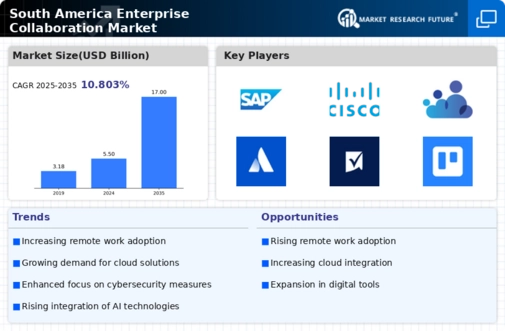The South America Enterprise Collaboration Market is characterized by a dynamic and rapidly evolving landscape, where organizations are increasingly prioritizing digital transformation to enhance collaboration across their teams. The competitive insights within this market reveal a mixture of established players and emerging disruptors that offer various collaboration solutions, allowing enterprises to streamline communication, synchronize efforts, and promote a culture of teamwork. Key drivers impacting this market include the growing adoption of remote work practices, rising demand for cloud-based collaboration tools, and an emphasis on improving organizational efficiency and productivity.
As companies strive to navigate the challenges posed by globalization while optimizing their operational capabilities, understanding the competitive nuances of this market becomes essential for succeeding in the region.Within the South America Enterprise Collaboration Market, SAP has established a significant presence by offering a range of solutions tailored to enhance productivity and collaboration within enterprises. SAP's strengths lie in its well-rounded portfolio of applications that integrates data management, analytics, and collaboration functionalities, providing organizations with a holistic approach to tackle their challenges.
The company is recognized for its ability to cater to various industry verticals, which allows it to leverage synergies across different sectors and provide customized solutions. Additionally, SAP's commitment to regional partnerships and local support enhances its competitive edge, enabling organizations in South America to optimize the use of its collaboration tools in their unique operational contexts.
Cisco operates as another formidable player in the South America Enterprise Collaboration Market, renowned for its comprehensive suite of collaboration tools and unified communication services. Cisco's offerings encompass various key products, such as its Webex platform, which facilitates video conferencing and team collaboration, alongside its robust range of networking solutions. The company's market presence in South America is bolstered by strategic mergers and acquisitions that have expanded its capabilities and client reach, allowing it to deliver enhanced collaboration and communication solutions.
Cisco's strengths lie in its innovative technology and strong brand recognition within the region, as well as its commitment to providing secure and reliable platforms, making it a trusted choice for enterprises looking to improve their collaborative efforts. By focusing on the evolving needs of the South American market, Cisco continues to establish itself as a leading player in fostering enhanced workflows and organizational collaboration throughout the region.

























Leave a Comment